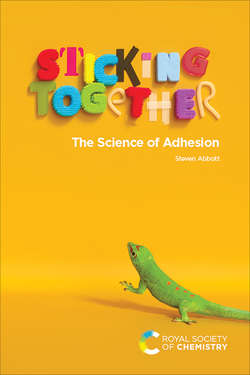Читать книгу Sticking Together - Steven Abbott - Страница 7
На сайте Литреса книга снята с продажи.
ОглавлениеGlossary
| Accelerator | An additive to make the adhesive set faster |
| Adherend | The thing being stuck via the adhesive |
| Adhesion promoter | A low-level additive that increases the adhesion |
| Alcohol | A molecule containing an –OH group |
| Amine | A group based on nitrogen and two hydrogens, shown as –NH2 |
| APTES | A common adhesion promoter that is both an amine and a silane |
| Backing tape | The carrier film for a PSA. Sometimes just called “backing” |
| Butt test | Pulling apart in a straight line |
| Catalyst | Something which makes a reaction go faster without itself being consumed by the reaction |
| Coalescence | Small, semi-solid particles flowing together to give a continuous solid |
| Crack energy | The energy trying to open a crack across the interface |
| Creep | Slow movement in a joint under a constant load |
| Curing | Setting solid via polymerization |
| Dahlquist | PSAs must be soft enough to meet the Dahlquist criterion for quick tack |
| Dispersant | A molecule added to a formulation to keep particles separated and free flowing |
| Dissipation | Converting work into useless heat – this soaks up crack energy and increases adhesion |
| DLVO | A theory of why small particles will or will not stick to each other, named after Derjaguin & Landau and Verwey & Overbeek |
| G′ & G″ | Measures of the elastic (G′) and fluid (G″) resistance to shear forces |
| Griffith's Law | The tendency of a crack to form increases with the size of defects in the system |
| Hydrophilic | Likes to be with water, dislikes oil |
| Hydrophobic | Dislikes water, likes to be with oil |
| Hydroxyl | A group made from one oxygen and one hydrogen, shown as –OH |
| Interface | The line between two adhesive components, e.g. between adherend and adhesive |
| Ion | A charged molecule or atom. Anions (negative ions) can polymerize cyanoacrylates |
| Molecular weight | For polymers this indicates how many monomer units were assembled and, therefore, the length of the chain |
| Monomer | A molecule that can react with other monomers to form a polymer |
| Peel test | Pulling up from the joint |
| Polymers: | |
| EVA | (Poly)Ethylene vinyl acetate |
| EVOH | (Poly)Ethylene vinyl alcohol |
| PE | Polyethylene, commonly called polythene. |
| HDPE/LDPE | High Density PE and Low Density PE |
| PP | Polypropylene |
| PMMA | Polymethylmethacrylate, commonly called Perspex or Plexiglas |
| PC | Polycarbonate |
| PET | Polyethyleneterephthalate, commonly called polyester |
| PDMS | Polydimethylsiloxane, commonly called silicone |
| PTFE | Polytetrafluoroethylene, commonly called Teflon |
| PVOH | Polyvinylalcohol |
| PVA | Polyvinylacetate. Confusingly PVA can also mean Polyvinylalcohol |
| PVB | Polyvinylbutyral |
| PVP | Polyvinylpyrrolidone |
| PSA | Pressure Sensitive Adhesive – common adhesive tape |
| Radical | A reactive molecule that produces a new radical after reacting with a monomer |
| Retarder | An additive to slow down the setting speed of the adhesive |
| Shear test | Pulling apart across the joint |
| Stefan's law | Squeezing a blob of adhesive gets much harder as its thickness decreases |
| Stress | Force acting across an area |
| Strain | Amount of stretch caused by a stress |
| Surfactant | “Surface active agent” used in cleaning (“detergent”) and creating emulsions (“emulsifier”). Has a hydrophilic head and hydrophobic tail |
| Tack | That easy to know but hard to define feeling of instant adhesiveness |
| -TES & -TMS | Triethoxy and Trimethoxy silanes, very useful adhesion promotion groups |
| TiO2 | Titanium dioxide – a key whitening pigment |
| van der Waals | The force that attracts all molecules and surfaces to each other |
| vdW | Abbreviation for van der Waals |
| VOC | Volatile Organic Compounds – typically solvents other than water |
| WLF | Williams, Landel and Ferry theory describing the equivalence of temperature and time |
